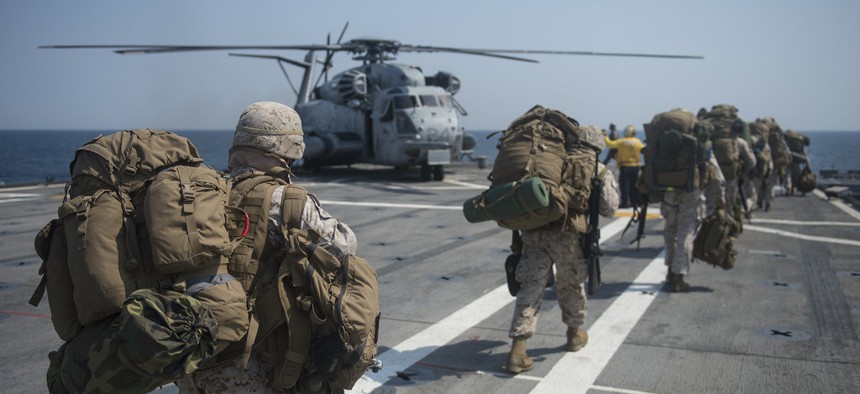
Marines assigned to the 31st Marine Expeditionary Unit load onto a CH-53E Super Stallion during Exercise Ssang Yong, on April 2, 2014. U.S. Navy photo by Mass Communication Specialist 3rd Class Todd C. Behrman
Why ISIL Hasn't Derailed America's Pivot to the Pacific
Deputy Defense Secretary Bob Work sees no risk with the Asia-Pacific rebalance while staying active in Europe and the Middle East. The real risks are with Congress. By Janine Davidson
The Council on Foreign Relations hosted Deputy Secretary of Defense Robert O. Work on September 30 for one of his first public events since his confirmation five months ago. Work, an experienced hand in maritime strategy and force disposition, explained the quiet steps by which the military rebalance to the Asia-Pacific has continued on course. Amid the loud headlines out of Iraq, Syria, and Ukraine, it is easy to forget that much of U.S. foreign policy is still being developed in anticipation of a “Pacific Century.” While unexpected contingencies like ISIS have dictated the tempo and focus of deployed troops, they have, according to Deputy Secretary Work, not hindered the overall rebalance, which largely continues apace.
What are some of the most tangible military steps taken since 2011? Work explains (emphasis added):
By 2020, both the Navy and the Air Force will have 60 percent of their forces in the Asia Pacific region. We may not have as many forces as we would like, but 60 percent of the forces will be in the Asia Pacific region. At the same time, PACOM is regaining Army units that were rotating through Afghanistan, and they’re returning with all of their equipment now, such as attack aviation assets like Apaches in Korea. The army will have more than 100,000 soldiers when all is said and done in the Asia Pacific region, including those on the West Coast … in Hawaii and Alaska and Japan.
And at the same time, the Marines are distributing and having four powerful Marine air-ground task force[s] geographically dispersed around the Pacific. All of those plans continue apace, regardless of how stressed we are in the budget.
…
The four biggest construction projects since the end of the Cold War are going on in the Pacific. There’s Camp Humphreys in Korea, where the Army is moving south of Seoul. That’s a $10 billion construction project. The Futenma Replacement Facility in Okinawa, which will allow the Marines to concentrate into the North and become more politically sustainable on the island is now moving forward. Guam is already starting. That will ultimately house 5,000 Marines at a new base there. And Iwakuni, Japan, what an incredible place. Literally, the Japanese government shaved the top off of a nearby mountain, conveyored the dirt down to a bay, put it on barges, and went around and reclaimed an enormous part, expanding the area so that the Navy’s carrier air wing that’s right now in Atsugi can move down there.
The Asia-Pacific also remains first priority for the United States’ most sophisticated military hardware. This includes the F-35 Joint Strike Fighter, a deployment of the Zumwalt destroyer class by 2018, and more THAAD and Patriot batteries to key locations. This also includes the Navy’s new P-8 maritime patrol aircraft and expanded Army electronic warfare capabilities that will be focused heavily in Korea.
Perhaps most significant of all (as I’ve written before) are our relationships throughout the region, including key alliances with South Korean, Japan, and Australia. The United States’ policy of multilateral, military-to-military engagement constitutes a critical piece of the rebalance strategy. As Work explains:
And none of this could be possible without [another] key component, which is our legal agreements and our alliances, and I have to tell you, our alliances with Japan, with South Korea, Australia, have never been stronger and are getting stronger all the time.
As Secretary Hagel has said, it’s really those treaty alliances that remain the backbone of our presence in the Asia Pacific, and it is the revitalization of all those alliances and partnerships which is a signature part of our Asia-Pacific rebalance and our entire global posture.
How can the personnel and materiel demands of the Asia-Pacific rebalance be met while also maintaining an active role in both Europe and the Middle East? Work argues for a more agile “dynamic presence” model of force deployment, by which divisions can be parceled into smaller force packages that are tailored to specific mission sets. As he explains:
What we’re trying to do is to try to figure out what is the minimum deterrent force that you might need in a theater and then have the rest of the force being more dynamically used across the world. This is a tough, tough problem, because it’s a different way of doing.
If I could say it this way, we are going from a demand side model, where the COCOMs demand forces and we provide them everything that we possibly can, to a supply side model in which we are setting forces out that keeps the balance between readiness and the surge and forward presence and then dynamically tasking it across the world.
As to the biggest obstacles to both defense strategy and broader national security, Work doesn’t place the blame on any particular nation or terror network. Instead, he points a finger squarely at the U.S. Congress. In his words, the 2011 Budget Control Act (sequestration) is “utterly stupid;” As well, Congress’ unwillingness to permit moderate reforms in defense acquisitions and compensation is “Lala Land.” The military cannot indefinitely maintain a high operating tempo in an age of shifting priorities and dwindling resources. Something will have to give.
Ultimately, Work’s message on the Asia-Pacific rebalance seems clear: the strategy is on course and on speed and will remain so despite continued security challenges and a high operational tempo in the Middle East. The primary obstacle is at home – the risk that Congress will fail to reverse sequestration.
This post appears courtesy of CFR.org.




